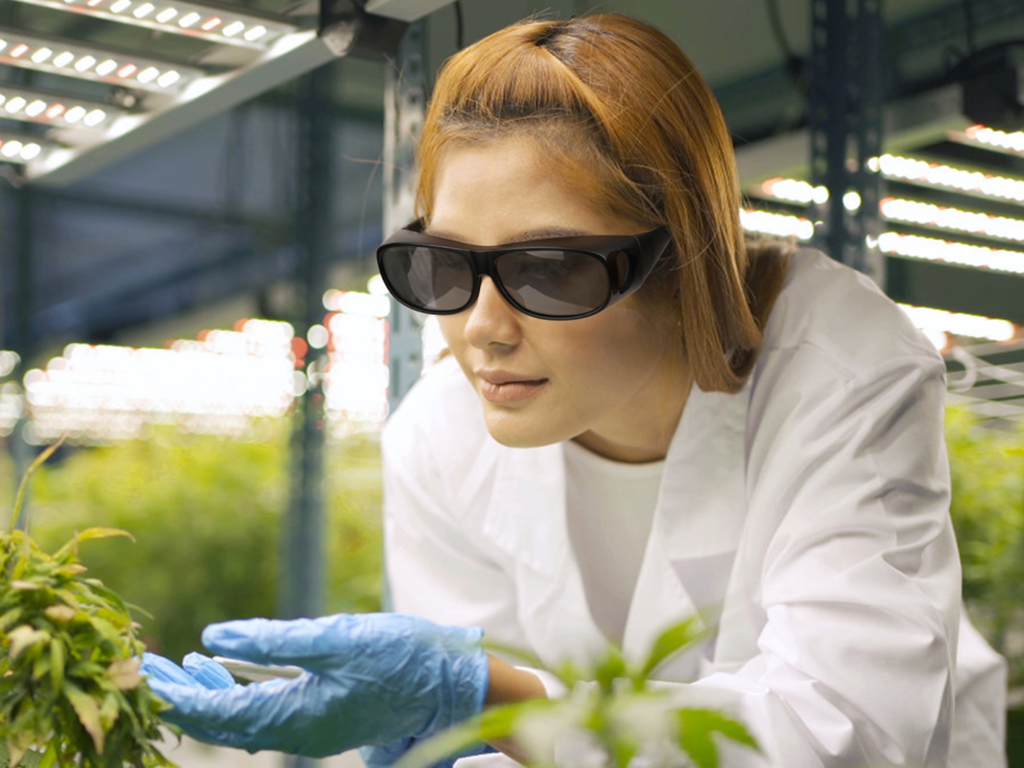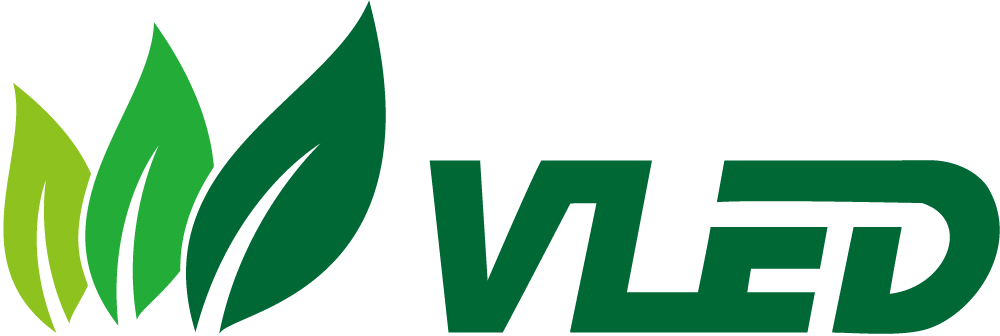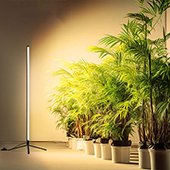Menu
Are LED Grow Lights Harmful to Humans?
No matter what type of grow light you use, if it’s not operated properly, it could potentially cause functional damage to your plants.
As a gardener who loves growing vegetables and cannabis, you’ve surely spent plenty of time pondering questions like how high to hang the lights, how to cool them down, and how much water is appropriate. All this effort is aimed at ensuring that the lights help your plants grow healthily instead of causing them stress or harm.
But let’s get real here, folks. It’s not just about the plants. Whether we’re talking about small home-use plant grow lights or large commercial LED grow lights, we have to be aware of the potential risks these things pose to us humans too.
LED lights are intense and bright, and staring at them for extended periods can do a number on your eyes. This fact is truer than ever, especially with today’s high-powered LEDs.
Remember this: don’t look directly into LED plant lights. If you need to be around them for a while, consider wearing sunglasses for protection. Take good care of your eyes – you only get one pair!
LED grow lights aren’t necessarily more dangerous than other types of plant lights.
It’s traditional High-Pressure Sodium (HPS) lamps that tend to raise more safety concerns due to their high operating temperatures which can cause burns, the risk of bulb explosion leading to fires, and the presence of mercury that is environmentally hazardous and contributes to higher energy consumption. These issues have been studied and confirmed by organizations such as CELMA in Europe.
Under normal circumstances, LED grow lights pose little to no harm to humans; the primary concern is usually their brightness. Just like with any other bright light source, prolonged exposure can cause discomfort or mild irritation to the eyes.
The key is to understand and be aware of the potential health risks associated with using LED lights so that precautions can be taken.
By taking proper care and implementing protective measures—like avoiding direct eye contact and using eye protection when necessary—we can minimize any concerns and safely use LED grow lights without worry.
Do LED Grow Lights Contain Mercury?
Some growers might ask: Do LED plant grow lights contain a dangerous heavy metal called mercury?
Here’s the answer: There used to be a misconception that, like some traditional plant lighting fixtures, LED grow lights could potentially harbor harmful substances like mercury. However, this notion is a misunderstanding; LED lights have been wrongly accused.
With advancements in technology, LED lights operate by emitting light through the use of diodes. In simpler terms, modern LED plant grow lights do not contain mercury at all.
Rest assured, there’s nothing to worry about. Today’s LED grow lights are clean and eco-friendly, and they are indeed mercury-free.
Danger of LED Grow Light Exposure
LED grow lights act like miniature indoor suns, meticulously simulating sunlight to nurture plants and promote their growth. You can even use adjustable spectrum LED lights that allow you to magically tweak the light conditions, making it seem like your plants are experiencing the changing seasons.
However, when you bring sunlight indoors, its effects on you mirror those on the plants. Much like spending an entire day under the sun, you must also consider the potential hazards involved.
I can assure you that excessive exposure without proper precautions, such as spending hours daily near the lights without eye protection, could lead to problems.
It’s not that standing next to an LED plant lamp will automatically cause injury; rather, the key point is to exercise caution when working in spaces equipped with high-powered LED grow lights for extended periods and take necessary protective measures.
So, what are the risks to watch out for with LED lighting? In brief, different wavelengths of light come with different implications. Generally, shorter wavelength light poses greater potential risks.
On the spectrum, infrared light is considered relatively harmless with its longer wavelengths, and red, orange, and yellow light are generally safe for human eyes. The real attention grabbers are blue light and ultraviolet (UV) radiation, both of which have shorter wavelengths and are more potent in their potential to cause harm.
Can Blue Light Harm People?
Exposure to excessive amounts of blue light does indeed present two significant concerns to be mindful of.
As our reliance on electronic devices that emit copious amounts of blue light, such as tablets and smartphones, increases, the topic of its impact on sleep has become increasingly prevalent.
Blue light disrupts your sleep patterns. This high-energy visible light suppresses the production of melatonin, a hormone crucial for regulating your sleep-wake cycle. Hence, the advice is often given to avoid watching TV or scrolling through your phone before bedtime.
If you spend extended periods exposed to blue light, your hormonal balance may be disturbed, leading to difficulty falling asleep or maintaining a healthy sleep schedule.
Additionally, blue light isn’t particularly kind to our eyes either. Your cornea doesn’t block blue light effectively, allowing it to penetrate straight to the retina. Over time, retinal cells may sustain damage from prolonged exposure, potentially increasing the risk of macular degeneration—a condition that can lead to vision impairment or loss.
However, this doesn’t mean using plant grow lights will necessarily result in blindness. It’s simply a reminder to take precautions when using such lights. Wearing blue-light blocking glasses, for instance, can provide a layer of protection and peace of mind during usage.
Potential Hazards of UV Light to Humans
As a cultivator, you’re aware that ultraviolet (UV) light is a secret weapon for boosting crop quality, with UVB rays prompting plants to produce more oils and resins for self-protection, thereby enhancing product quality.
When it comes to ultraviolet light, you likely know from your sunscreen-slathering experiences that humans need to be cautious too, and this goes beyond mere skin protection. Let’s delve deeper.
There are three types of ultraviolet radiation: UVA, UVB, and UVC. UVC has the shortest wavelength and is the most powerful, posing the greatest potential for harm. While the sun emits all three forms, fortunately, Earth’s atmosphere blocks most of the harmful UV radiation. Most LED grow light manufacturers exclude UVC from their supplementary UV lamps for this reason.
However, many UV lamps still include UVA and UVB. As you might know, prolonged unprotected exposure to UV radiation can increase the risk of skin cancer. This doesn’t mean you should panic or abandon the use of supplemental UVB lighting for enhanced cultivation results. The key lies in taking necessary precautions to protect your skin.
Similar to blue light, UVA can also penetrate the retina, and long-term exposure may be associated with retinal damage, including conditions like cataracts. While the cornea partially blocks UVB, it still means that the cornea takes on some strain.
UVB can lead to corneal inflammation or surface issues of the eye. Therefore, when dealing with ultraviolet light, whether for skin or eye protection, it’s essential to be smart and take the right precautions.
LED Grow Light Safety
Fortunately, safeguarding against all the potential risks mentioned earlier is quite manageable, so you don’t have to compromise between enjoying the benefits of LED grow lights and personal safety. Simply follow these straightforward safety measures:
- Wear specialized grow room glasses. While sunglasses can block harmful rays, they may distort the colors of your plants, making it difficult to spot issues promptly. If you are going to be staying indoors for a long time, wear your grow room glasses that can protect your eyes. It completely blocks UV, reduces blue light, and reduces glare.

- Hang the lights at least 8 feet above ground level and maintain a distance of at least 3 feet between the lights and any fixtures emitting UV radiation. In confined growing environments, such as grow tents, this might require extra planning to ensure a suitable setup.
- When working, wear long-sleeved clothing to minimize exposed skin.
- If you have employees assisting you, make sure to share these safety tips with them and post clear warning signs in conspicuous locations reminding everyone to protect themselves from UVA and UVB radiation.
Just as you carefully design your plant growth systems to ensure the safety and health of your plants, extend the same level of care and consideration to your well-being and that of your team members. Implement comprehensive safeguards for a holistic approach to protection.
Get in touch with us!
From custom light planning, to tailored quotes, and everything in between, our team of horticulture experts are always ready to assist.




